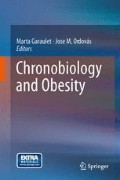Abstract
The discovery of the Clock mutant mouse in 1994 and the identification and cloning of the gene underlying the mutation, named Clock, was a landmark finding in the history of the field of mammalian circadian rhythms. Unexpected at the time, the discovery of the Clock mutant animal would eventually lead to an entire new approach to the study and treatment of obesity. The report in 2005 that the Clock mutant animal is obese and shows signs of the metabolic syndrome opened up an entire new field of obesity research. Although still in the early stages of discovery, linking circadian clock genes to energy regulation has clear implications for future studies on body weight regulation at the mechanistic level, as well as for the development of new therapeutic approaches for combatting the epidemic of obesity, as well as metabolic disorders, including diabetes.
Access this chapter
Tax calculation will be finalised at checkout
Purchases are for personal use only
References
Alenghat T, Meyers K, Mullican SE, Leitner K, Adeniji-Adele A, Avila J, Bućan M, Ahima RS, Kaestner KH, Lazar MA (2008) Nuclear receptor corepressor and histone deacetylase 3 govern circadian metabolic physiology. Nature 456(7224):997–1000
Allada R, Emery P, Takahashi JS, Rosbash M (2001) Stopping time: the genetics of fly and mouse circadian clocks. Annu Rev Neurosci 24:1091–1119
Andrews JL, Zhang X, McCarthy JJ, McDearmon EL, Hornberger TA, Russell B, Campbell KS, Arbogast S, Reid MB, Walker JR, Hogenesch JB, Takahashi JS, Esser KA (2010) CLOCK and BMAL1 regulate MyoD and are necessary for maintenance of skeletal muscle phenotype and function. PNAS 107(44):19090–19095
Antoch MP, Song EJ, Chang AM, Vitaterna MH, Zhao Y, Wilsbacher LD, Sangoram AM, King DP, Pinto LH, Takahashi JS (1997) Functional identification of the mouse circadian Clock gene by transgenic BAC rescue. Cell 89(4):655–667
Arble DM, Ramsey KM, Bass J, Turek FW (2010) Circadian disruption and metabolic disease: findings from animal models. Best Pract Res Clin Endocrinol Metab 24:785–800
Bass J, Takahashi JS (2010) Circadian integration of metabolism and energetics. Science 330(6009):1349–1354
Dunlap JC (1999) Molecular bases for circadian clocks. Cell 96:271–290
Easton A, Arbuzova J, Turek FW (2003) The circadian Clock mutation increases exploratory activity and escape-seeking behavior. Genes Brain Behav 2(1):11–19
King DP, Zhao Y, Sangoram AM, Wilsbacher LD, Tanaka M, Antoch MP, Steeves TDL, Vitaterna MH, Kornhauser JM, Lowrey PL, Turek FW, Takahashi JS (1997) Positional cloning of the mouse circadian Clock gene. Cell 89:641–653
Miller BH, Olson SL, Turek FW, Levine JE, Horton TH, Takahashi JS (2004) Circadian clock mutation disrupts estrous cyclicity and maintenance of pregnancy. Curr Biol 14(15):1367–1373
Miller BH, Olson SL, Levine JE, Turek FW, Horton TH, Takahashi JS (2006) Vasopressin regulation of the proestrous luteinizing hormone surge in wild-type and Clock mutant mice. Biol Reprod 75(5):778–784
Naylor E, Bergmann BM, Krauski K, Zee PC, Takahashi JS, Vitaterna MH, Turek FW (2000) The circadian Clock mutation alters sleep homeostasis in the mouse. J Neurosci 20(21):8138–8143
Panda S, Antoch MP, Miller BH, Su AI, Schook AB, Straume M, Schultz PG, Kay SA, Takahashi JS, Hogenesch JB (2002) Coordinated transcription of key pathways in the mouse by the circadian clock. Cell 109(3):307–320
Penev PD, Zee PC, Turek FW (1997) Quantitative analysis of the age-related fragmentation of hamster 24-h activity rhythms. Am J Physiol 273:R2132–R2137
Preitner N, Damiola F, Lopez-Molina L, Zakany J, Duboule D, Albrecht U, Schibler U (2002) The orphan nuclear receptor REV-ERBalpha controls circadian transcription within the positive limb of the mammalian circadian oscillator. Cell 110(2):251–260
Ralph MR, Menaker M (1988) A mutation of the circadian system in golden hamsters. Science 241(4870):1225–1227
Science (1998) Breakthrough of the year. Science 282(5397):2157–2161
Shearman LP, Zylka MJ, Weaver DR, Kolakowski LF Jr, Reppert SM (1997) Two period homologs: circadian expression and photic regulation in the suprachiasmatic nucleus. Neuron 19(6):1261–1269
Shearman LP, Sriram S, Weaver DR, Maywood ES, Chaves I, Zheng B, Kume K, Lee CC, van der Horst GT, Hastings MH, Reppert SM (2000) Interacting molecular loops in the mammalian circadian clock. Science 288(5468):1013–1019
Staels B (2006) When the Clock stops ticking, metabolic syndrome explodes. Nat Med 12(1):54–55
Stokkan KA, Yamazaki S, Tei H, Sakaki Y, Menaker M (2001) Entrainment of the circadian clock in the liver by feeding. Science 291(5503):490–493
Sun ZS, Albrecht U, Zhuchenko O, Bailey J, Eichele G, Lee CC (1997) RIGUI, a putative mammalian ortholog of the Drosophila period gene. Cell 90(6):1003–1011
Tosini G, Menaker M (1996) Circadian rhythms in cultured mammalian retina. Science 272(5260):419–421
Turek FW, Van Cauter E (1994) Chapter 43: rhythms in reproduction. In: Knobil E, Neill JD (eds) The physiology of reproduction, 2nd edn. Raven, New York, pp 487–540
Turek FW, Joshu C, Kohsaka A, Lin E, Ivanova G, McDearmon E, Laposky A, Losee-Olson S, Easton A, Jensen DR, Eckel RH, Takahashi JS, Bass J (2005) Obesity and metabolic syndrome in circadian clock mutant mice. Science 308:1043–1045
Turek FW (2008) Circadian clocks: tips from the tip of the iceberg. Nature 456(7224):881–883
Vitaterna MH, King DP, Chang A-M, Kornhauser JM, Lowrey PL, McDonald JD, Dove WF, Pinto LH, Turek FW, Takahashi JS (1994) Mutagenesis and mapping of a mouse gene, Clock, essential for circadian behavior. Science 264:719–725
Author information
Authors and Affiliations
Corresponding author
Editor information
Editors and Affiliations
Rights and permissions
Copyright information
© 2013 Springer Science+Business Media New York
About this chapter
Cite this chapter
Turek, F.W. (2013). Discovery of the Clock Mutant and the First Mammalian Clock Gene and the Links to Obesity: Starting with Animal #25. In: Garaulet, M., Ordovás, J. (eds) Chronobiology and Obesity. Springer, New York, NY. https://doi.org/10.1007/978-1-4614-5082-5_1
Download citation
DOI: https://doi.org/10.1007/978-1-4614-5082-5_1
Published:
Publisher Name: Springer, New York, NY
Print ISBN: 978-1-4614-5081-8
Online ISBN: 978-1-4614-5082-5
eBook Packages: Biomedical and Life SciencesBiomedical and Life Sciences (R0)

